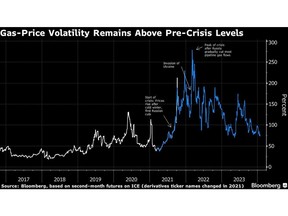Persistent price fluctuations in the European natural gas market limit the willingness of industrial companies to increase their fuel consumption, even after the worst of the region’s energy crisis has passed.

Article content
(Bloomberg) — Persistent price fluctuations in Europe’s natural gas market are limiting industrial companies’ willingness to increase fuel consumption, even after the worst of the region’s energy crisis has passed.
Implied volatility of the Dutch benchmark gas – a measure of the price of derivative contracts – has eased since the start of the year, a sign that confidence in the market is strengthening. It nevertheless remains well above pre-crisis levels, as price fluctuations have become more frequent. With summer contracts trading at higher levels than this winter, a substantial increase in industrial consumption still seems far away.
Advertisement 2
Article content
Article content
Volatility has become a dominant feature of the European market as it transforms into an international hub for gas trading. This means the region is more exposed to global supply risks – from violence in the Middle East to liquefied natural gas production disruptions – although it is considered to be on relatively stable footing otherwise. of this winter.
Read more: Europe enters a new world after a crippling energy crisis
“The recovery of industrial activity requires a certain degree of confidence in price stability and, recently, we have seen a wide range of possible outcomes, which makes hedging – particularly on options – very difficult and expensive” , said Martijn Rats, global commodities strategist. and head of European energy research at Morgan Stanley. “It is not about the absolute price level, but about the expected volatility in the markets.”
The industry has recently seen signs of returning to activity, but gas consumption remains historically low as economic recovery in Europe is expected to take time. Major consumers – from steel to chemical makers – are showing reluctance to run their businesses at full capacity after a record rise in energy prices during the crisis prompted them to curb production.
Advertisement 3
Article content
Gas demand in the European Union was 19% lower last year than its average level for 2019-2021, with consumption reductions split equally between the electricity sector, industry and utilities. households, according to the Bruegel think tank in Brussels. More recent data from Independent Commodity Intelligence Services shows an 11% rebound in January compared to the same month last year, but that is still 14% below the five-year average for the period.
Demand is being held back by a number of factors, including increased renewable energy production and a generally mild winter. There are also uncertainties over whether new global LNG capacity will come online only from 2025 and whether the transit agreement between Russia and Ukraine expires at the end of the year.
“It’s disappointing to see how far prices have fallen and demand hasn’t really come back,” said Morgan Stanley’s Rats. “But volatility is also very high.”
The persistent demand deficit is one of the main reasons why European gas prices have extended their recent decline. Dutch front-month futures were trading down 1.3% on Friday at €28.63 per megawatt hour at 8:55 a.m. in Amsterdam.
—With help from Andrew Reierson.
Article content



